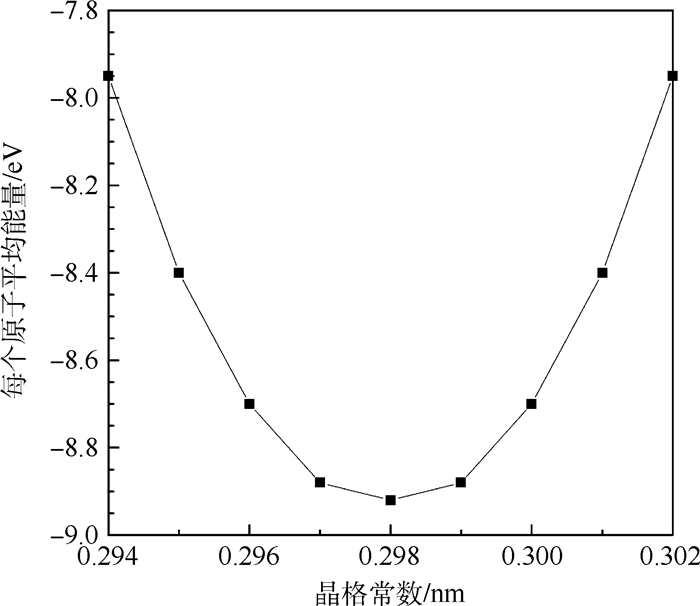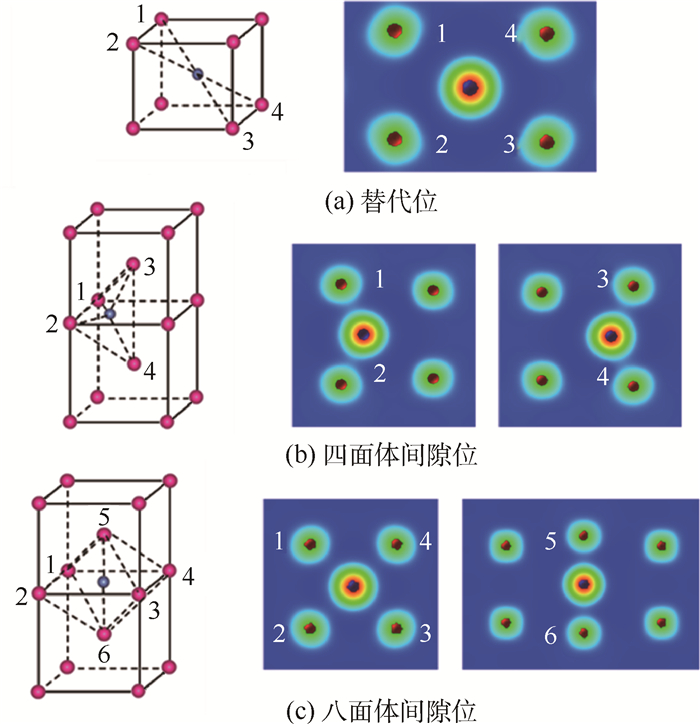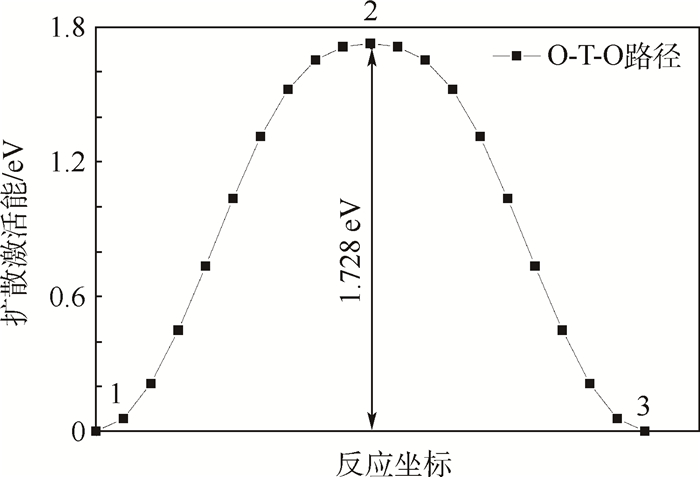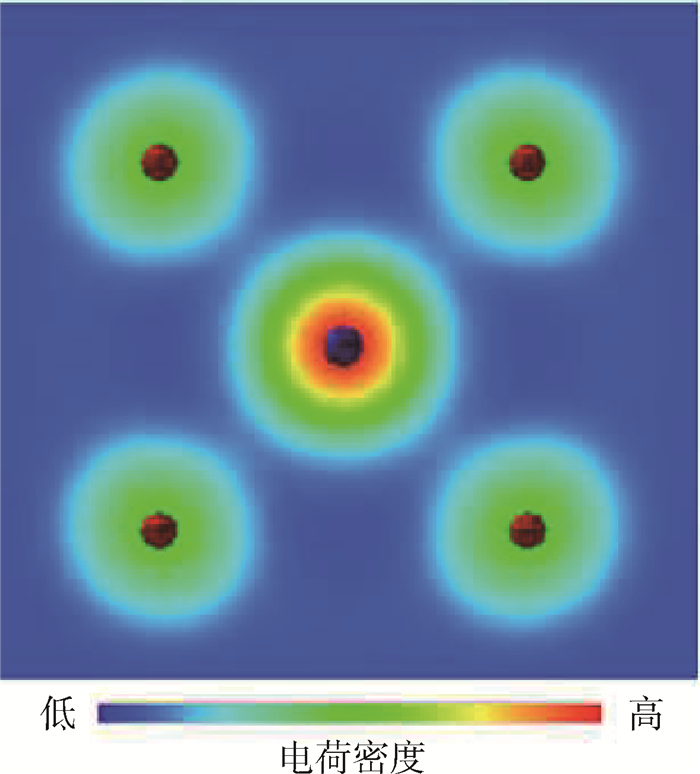-
摘要:
钒(V)是核聚变反应堆结构材料的重要候选材料。实验表明杂质氧(O)会对V的结构和力学性能产生极大的影响。采用基于密度泛函理论的第一性原理方法研究了O在V中热力学稳定性、扩散特性以及与缺陷空位的相互作用。O在V中易于占据八面体间隙位,其溶解能为-4.942 eV。O在间隙位的最佳扩散路径为八面体间隙位→四面体间隙位→八面体间隙位,扩散激活能为1.728 eV,在此基础上对不同温度下的扩散系数在文中给出了详细分析。O在V中与空位存在很强的吸引相互作用,1个O原子和2个O原子被空位捕获时的捕获能分别为-0.484 eV和-0.510 eV。当O原子的数量超过3,其捕获能变为正值0.382 eV,因此单空位最多能够结合2个O原子,这意味着“O1-vacancy”和“O2-vacancy”团簇在V中很容易形成。这些研究结果将对V基合金在核聚变反应堆中的最终应用具有一定的参考价值。
Abstract:Vanadium (V) is identified as a promising candidate of the structural materials in fusion reactors. Experimental results have demonstrated that the impurity oxygen (O) has great influence on the structure and mechanical properties of V. Employing a first-principles method based on the density functional theory, we study the stability and diffusion property of impurity O as well as its interaction with defect vacancy in V. O atom is energetically favorable to occupy the octahedral insterstitial site with the solution energy of -4.942 eV. The intrinsic optimal diffusion route of O in the interstitial site is octahedral insterstitial site→tetrahedral insterstitial site→octahedral insterstitial site, and the diffusion activation energy is calculated to be 1.728 eV. The diffusion coefficients of O at the different temperature are systematically analyzed. We demonstrate that there is the strong attractive interaction between O and vacancy in V. The trapping energies of one and two O atoms are-0.484 eV and -0.510 eV, respectively. With the increase of the number of O atoms, the trapping energy of the third O becomes the positive value of 0.382 eV, meaning that vacancy cannot bind the additional O atom again. Thus, one vacancy can accommodate as many as two O atoms. It is revealed that the "O1-vacancy" and "O2-vacancy" clusters are easily formed in V. The current results can provide a very useful reference for V as a candidate structural material in a fusion reactor.
-
Key words:
- vanadium /
- impurity oxygen /
- diffusion property /
- defect vacancy /
- first-principles
-
表 1 O在128原子V超晶胞中八面体间隙位和四面体间隙位中溶解能的测试结果
Table 1. Tested solution energy results of O at OIS and TIS in 128-atom V supercell
eV 测试对象 截止能 k点 250 300 350 400 450 1×1×1 2×2×2 3×3×3 4×4×4 EOs(OIS) -4.928 -4.935 -4.942 -4.943 -4.943 -4.902 -4.935 -4.942 -4.942 EOs(TIS) -3.693 -3.761 -3.779 -3.778 -3.778 -3.689 -3.762 -3.779 -3.778 注:先选取一个较大的8×8×8 k点对截止能进行测试,测试结果取为350 eV,并采用350 eV的截止能对k点进行测试,测试结果取为3×3×3 k点。 表 2 O在V中300 ~1000K温度范围内的扩散系数
Table 2. Diffusion coefficient of O in V at different temperatures from 300 to 1000K
T/K D/(m2·s-1) 300 2.16×10-36 400 3.91×10-29 500 8.84×10-25 600 7.05×10-22 700 8.35×10-20 800 3.00×10-18 900 4.86×10-17 1000 4.51×10-16 -
[1] LIU Y L, ZHOU H B, JIN S, et al.Effects of H on electronic structure and ideal tensile strength of W:A first-principles calculation[J].Chinese Physics Letters, 2010, 27(12):127101. doi: 10.1088/0256-307X/27/12/127101 [2] LIU Y L, JIN S, ZHANG Y, et a.l Interaction between impurity nitrogen and tungsten:A first-principles investigation[J].Chinese Physics B, 2012, 21(1):016105. doi: 10.1088/1674-1056/21/1/016105 [3] LIU Y L, GAO A Y, LU W, et al. Optimal electron density mechanism for hydrogen on the surface and at a vacancy in tungsten[J].Chinese Physics Letters, 2012, 29(7):077101. doi: 10.1088/0256-307X/29/7/077101 [4] LIU Y L, LU W, GAO A Y, et al.First-principles investigation on diffusion behaviours of H isotopes:From W(110) surface into bulk and in bulk W[J].Chinese Physics B, 2012, 21(12):126103. doi: 10.1088/1674-1056/21/12/126103 [5] LIU Y L, ZHANG Y, HONG R J, et al.Study of theoretical tensile strength of Fe by a first-principles computational tensile test[J].Chinese Physics B, 2009, 18(5):1923-1930. doi: 10.1088/1674-1056/18/5/033 [6] SMITH D L, CHUNG H M, LOOMIS B A, et al.Reference vanadium alloy V-4Cr-4Ti for fusion application[J].Journal of Nuclear Materials, 1996, 233-237:356-363. doi: 10.1016/S0022-3115(96)00231-0 [7] CHUNG H M, LOOMIS B A, SMITH D L.Development and testing of vanadium alloys for fusion applications[J].Journal of Nuclear Materials, 1996, 239:139-156. doi: 10.1016/S0022-3115(96)00676-9 [8] SATOU M, ABE K, KAYANO H.High-temperature deformation of modified V-Ti-Cr-Si type alloys[J].Journal of Nuclear Materials, 1991, 179:757-761. [9] SATO S, TANAKA T, HORI J, et al.Radioactivity of the vanadium-alloy induced by D-T neutron irradiation[J].Journal of Nuclear Materials, 2004, 329:1648-1652. [10] MARKOVSKIJ D V, FORREST R A, KOVALCHUK V D, et al.Experimental activation study of some Russian vanadium alloys with 14-MeV neutrons at SNEG-13 facility[J].Fusion Engineering and Design, 2001, 58:591-594. [11] BLOOM E E, CONN R W, DAVIS J W, et al.Low activation materials for fusion applications[J].Journal of Nuclear Materials, 1984, 122(1):17-26. [12] BUTTERWORTH G J, MCCARTHY K A, SMOLIK G R, et al.Safety and environmental aspects of vanadium alloys[J].Journal of Nuclear Materials, 1994, 212:667-672. [13] TSAI H, BRAY T S, MATSUI H, et al.Effects of low-temperature neutron irradiation on mechanical properties of vanadium-base alloys[J].Journal of Nuclear Materials, 2000, 283:362-366. [14] LOOMIS B A, SMITH D L, GARNER F A.Swelling of neutron-irradiated vanadium alloys[J].Journal of Nuclear Materials, 1991, 179:771-774. [15] OHNUKI S, TAKAHASHI H, KINOSHITA H, et al.Void formation and precipitation in neutron irradiated vanadium alloys[J].Journal of Nuclear Materials, 1988, 155:935-939. [16] LOOMIS B A, SMITH D L.Vanadium alloys for structural applications in fusion systems:A review of vanadium alloy mechanical and physical properties[J].Journal of Nuclear Materials, 1992, 191:84-91. [17] BORGSTEDT H U, GRUNDMANN M, KONYS J, et al.A vanadium alloy for the application in a liquid metal blanket of a fusion reactor[J].Journal of Nuclear Materials, 1988, 155:690-693. [18] BORGSTEDT H U, FEUERSTEIN H.The solubility of metals in Pb-17Li liquid alloy[J].Journal of Nuclear Materials, 1992, 191:988-991. [19] SMITH D L, CHUNG H M, LOOMIS B A, et al.Development of vanadium-base alloys for fusion first-wall—Blanket applications[J].Fusion Engineering and Design, 1995, 29:399-410. doi: 10.1016/0920-3796(95)80046-Z [20] LOOMIS B A, HULL A B, SMITH D L.Evaluation of low-activation vanadium alloys for use as structural material in fusion reactors[J].Journal of Nuclear Materials, 1991, 179:148-154. [21] SATO T, OKITA T, SEKIMURA N.Effects of solid transmutation and helium on microstructural evolution in neutron-irradiated vanadium[J].Journal of Nuclear Materials, 2002, 307:385-388. [22] 谌继明, 室贺健夫, 许增裕, 等.聚变应用钒合金抗氢脆性能的合金化设计[J].金属学报, 2002, 38(8):839-843. http://www.cnki.com.cn/Article/CJFDTOTAL-JSXB200208010.htmCHEN J M, MUROGA T, XU Z Y, et al.Alloying design for fusion application vanadium alloys based on hydrogen embrittlement resistance[J].Acta Metallurgica Sinica, 2002, 38(8):839-843(in Chinese). http://www.cnki.com.cn/Article/CJFDTOTAL-JSXB200208010.htm [23] 吴仲成, 彭述明, 杨茂年, 等.有效介质理论计算He原子在金属钒中的扩散行为[J].金属学报, 2004, 40(1):36-39. http://www.cnki.com.cn/Article/CJFDTOTAL-JSXB200401006.htmWU Z C, PENG S M, YANG M N, et al.Calculation of diffusion barriers for helium atom in vanadium by effective medium theory[J].Acta Metallurgica Sinica, 2004, 40(1):36-39(in Chinese). http://www.cnki.com.cn/Article/CJFDTOTAL-JSXB200401006.htm [24] ZHANG P B, ZHAO J J, QIN Y, et al.Stability and dissolution of helium-vacancy complexes in vanadium solid[J].Journal of Nuclear Materials, 2011, 419:1-8. doi: 10.1016/j.jnucmat.2011.08.023 [25] ZHANG P B, ZHAO J J, QIN Y, et al Stability and migration property of helium and self defects in vanadium and V-4Cr-4Ti alloy by first-principles[J].Journal of Nuclear Materials, 2011, 413:90-94. doi: 10.1016/j.jnucmat.2011.03.031 [26] KURTZ R J, ABE K, CHERNOV V M, et al.Recent progress on development of vanadium alloys for fusion[J].Journal of Nuclear Materials, 2004, 329:47-55. [27] ALKHAMEES A, ZHOU H B, LIU Y L, et al.First-principles investigation on dissolution and diffusion of oxygen in tungsten [J].Journal of Nuclear Materials, 2009, 393:508-512. doi: 10.1016/j.jnucmat.2009.07.012 [28] ALKHAMEES A, ZHOU H B, LIU Y L, et al.Vacancy trapping behaviors of oxygen in tungsten:A first-principles study[J].Journal of Nuclear Materials, 2013, 437:6-10. doi: 10.1016/j.jnucmat.2013.01.317 [29] KRESSE G, HAFNER J.Ab initio molecular dynamics for liquid metals[J].Physical Review B, 1993, 47(1):558-561. doi: 10.1103/PhysRevB.47.558 [30] KRESSE G, FURTHMVLLER J.Efficient iterative schemes for ab initio total-energy calculations using a plane-wave basis set[J].Physical Review B, 1996, 54(16):11169-11186. doi: 10.1103/PhysRevB.54.11169 [31] PERDEW J P, BURKE K, ERNZERHOF M.Generalized gradient approximation made simple[J].Physical Review Letters, 1996, 77:3865-3868. doi: 10.1103/PhysRevLett.77.3865 [32] KRESSE G, JOUBERT D.From ultrasoft pseudopotentials to the projector augmented-wave method[J].Physical Review B, 1999, 59(3):1758-1775. doi: 10.1103/PhysRevB.59.1758 [33] KITTEL C.Introduction to solid state physics[M].7th ed.New York:Wiley, 1996:23. [34] MONKHORST H J, PACK J D.Special points for Brillouin-zone integrations[J].Physical Review B, 1976, 13(12):5188-5192. doi: 10.1103/PhysRevB.13.5188 [35] HOGLUND L, AGREN J.Simulation of carbon diffusion in steel driven by a temperature gradient[J].Journal of Phase Equilibria and Diffusion, 2010, 31(3):212-215. doi: 10.1007/s11669-010-9673-0 [36] WERT C, ZENER C.Interstitial atomic diffusion coefficients[J].Physical Review, 1949, 76(8):1169-1175. doi: 10.1103/PhysRev.76.1169 [37] HENKELMAN G.A climbing image nudged elastic band method for finding saddle points and minimum energy paths[J].Journal of Chemical Physics, 2000, 113(22):9901-9904. doi: 10.1063/1.1329672 [38] FUKAI Y, ŌKUMA N.Formation of superabundant vacancies in Pd hydride under high hydrogen pressures[J].Physical Review Letters, 1994, 73(12):1640-1643. doi: 10.1103/PhysRevLett.73.1640 [39] LU G, KAXIRAS E.Hydrogen embrittlement of aluminum:The crucial role of vacancies[J].Physical Review Letters, 2005, 94(15):155501. doi: 10.1103/PhysRevLett.94.155501 [40] GAVINI V, BHATTACHARYA K, ORTIZ M.Vacancy clustering and prismatic dislocation loop formation in aluminum[J].Physical Review B, 2007, 76(18):180101. doi: 10.1103/PhysRevB.76.180101 [41] DISTEFANO J R, DEVAN J H.Reactions of oxygen with V-Cr-Ti alloys[J].Journal of Nuclear Materials, 1997, 249:150-158. doi: 10.1016/S0022-3115(97)00217-1 [42] HAUTOJARVI P, JOHANSSON J, VEHANEN A.Vacancy-carbon interaction in iron[J].Physical Review Letters, 1980, 44(20):1326-1329. doi: 10.1103/PhysRevLett.44.1326 -








 下载:
下载:








